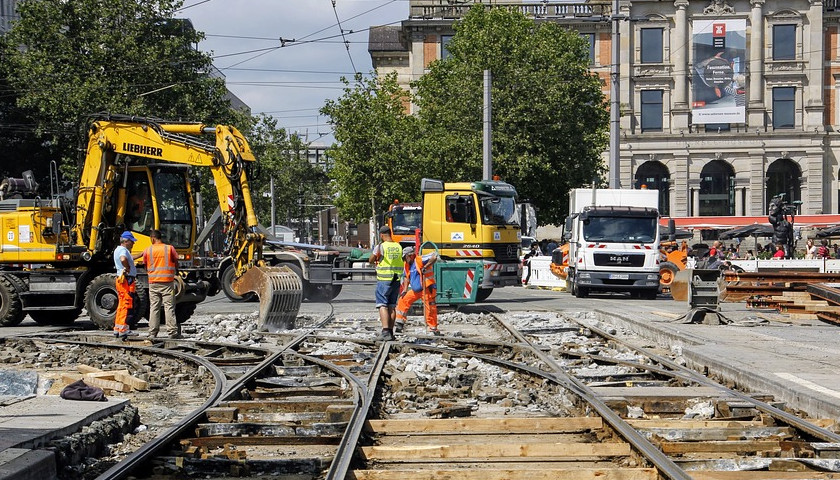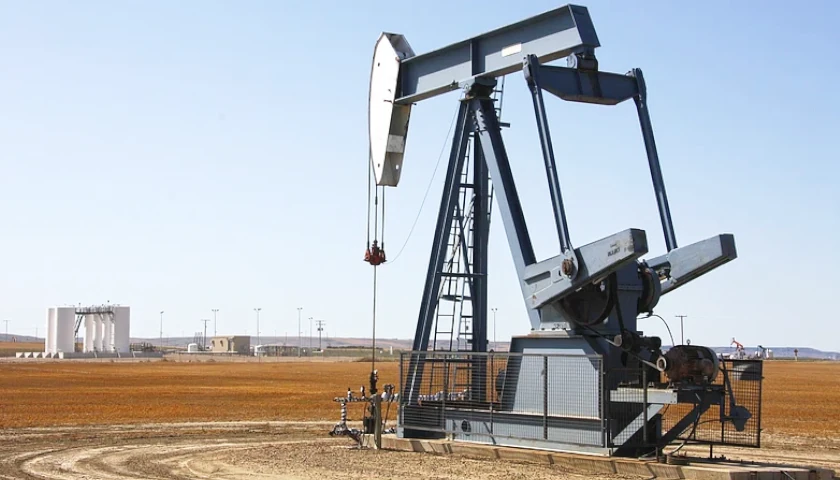by Mike Gallagher
Everything these days seems to count as infrastructure. Child care is infrastructure. Elder care is infrastructure. Even court-packing is infrastructure. But in a world where everything is infrastructure, nothing is infrastructure, and our existing infrastructure suffers as a result. Take, for example, President Biden’s recently revised American Jobs Plan, a $2 trillion boondoggle that prioritizes pretty much everything except for the roads, bridges, ports, and waterways that constitute actual infrastructure. The plan comes after we already appropriated $605 billion for infrastructure and transportation in the last three COVID-19 relief bills.
Perhaps this is why the talks between Senate Republicans and President Biden over this bill have just collapsed. Both parties seem to be starting from the same flawed premise: Let’s haggle over how much money D.C. spends on infrastructure rather than reevaluating the federal government’s role in infrastructure spending. Consider that in most categories, states and localities foot up to 80% to 90% of infrastructure costs. We need to ensure that federal dollars are not displacing state dollars that then move to other priorities, resulting in a no net increase in infrastructure spending. If we have an infrastructure spending proposal on the table, it must prioritize things like cross-state bridges, interstate travel, and large-scale water projects. Sending tax dollars to D.C. just for D.C. to return the dollars back — via outdated bureaucracy that dilutes them — to the states does not make sense unless the money funds federal and interstate projects.
Before wasting trillions of dollars we do not have on non-infrastructure, we need to take a step back and get outside the D.C. groupthink. If President Biden and Secretary of Transportation Pete Buttigieg are sincere in wanting an innovative, bipartisan proposal, here is how they can earn it.
Step 1: Back to the Future on User Fees
To repair our roads, we could do a lot worse than learning from President Dwight Eisenhower. One of Eisenhower’s core insights involved user fees in the form of a federal gasoline tax. In 1954, a 2-cent per gallon gas tax went to the Treasury, which apportioned part of it to pay for highway construction. Under this system, gas tax revenues were frequently tapped to pay for other federal priorities, and highway construction suffered as a result. Ike intuitively understood that funds generated by highway users should pay for highway construction. One of his first infrastructure proposals prevented a planned half-cent reduction in the gas tax. Ike’s decision allowed the federal-aid highway program to grow by $225 million while expanding the share that would go to highway construction.
Unfortunately, we have drifted away from that vision. Over the years, the federal government has abused the Highway Trust Fund’s Mass Transit Account to fund everything from outdated streetcars to exorbitant rail systems. In effect, it subsidized state and local governments to funnel gas tax money to transit projects and their users that do not otherwise participate in the fund’s money-making mechanism in the first place. Unsurprisingly, the result is that the Highway Trust Fund loses billions each year, and Congress continues to transfer general fund revenues over to mask the overspending. The Congressional Budget Office estimates it will become insolvent later this year.
As transportation policy expert Robert Poole has argued, returning to a strict user-fee system would help restore the original promise of the Highway Trust Fund by allowing Americans to pay directly for the highway services they utilize, much like their water or natural gas bill. By implementing a user-fee-based system for every federally funded infrastructure project, old and new, highways and transit, federal money would directly go to the type of infrastructure it was meant to pay for.
Step 2: Next Generation Funding
When it comes to funding infrastructure, we should also recognize the world has changed since Ike’s day. Vehicles – both electric and gas – are getting more efficient, weakening the fuel-tax funding model. Transitioning to a Vehicle Miles Traveled fee is the best long-term option. It will, however, take years to enact the pilot projects necessary and build trust in the idea with the American people. This means that we need next-generation proposals to help ensure our infrastructure projects receive adequate funding in addition to the gas tax. Two ideas are compelling.
First is value capture financing. Value capture rests on the principle that when federal, state, or local governments make infrastructure investments (for example, adding a new transit line), it tends to increase the value of the impacted land. Traditionally, that additional value benefits the landowner but is “lost” to the broader public. As the name implies, value capture financing seeks to “capture” some of the wealth generated by increased property values through taxes or other mechanisms to help pay for the associated infrastructure project.
The second is asset recycling. Under asset recycling, rather than forcing taxpayers to cover the entirety of new infrastructure costs, the government sells or leases publicly owned assets to the private sector and “recycles” the proceeds into new infrastructure. Australia used asset recycling over a two-year period beginning in 2014 to spur infrastructure improvements that incentivize state and territory governments to sell or lease their government-owned assets and invest the proceeds into new infrastructure. The result? Three billion dollars in Australian federal incentives to states and territories unlocked $17 billion in new infrastructure development. As of 2018, more cranes and tunnel boring machines were in Sydney than any other city in the world. America desperately needs to learn from this approach to cut into our crippling trillion-dollar infrastructure maintenance backlog through unleashing private sector investment.
In addition to next-generation funding, infrastructure quality measurements need to be reassessed. The opaque quality of definitive information about America’s infrastructure funding gap, and how much it will cost to close, led to apocalyptic ratings from organizations like the American Society of Civil Engineers. How reliable is a C- rating from the ASCE? How should we assess the information underlying that rating? We need to have quantifiable data that defines our infrastructure needs. More data are required before $1.7 trillion of taxpayer money is spent on infrastructure. Congress should mandate that our federal departments provide us with broader yet more standard metrics that confirm and reinforce the need for such robust spending hauls.
Step 3: Regulatory Reform
Even if we get infrastructure funding right, America still has the highest infrastructure cost in the world. Unless we bring down costs, it ultimately will not matter how much funding we generate or how creative our proposals get. Cost reduction requires modernizing our byzantine regulatory approval process.
On his second day in office, President Biden repealed the Trump-era “One Federal Decision” executive order designed to speed up the environmental review process in which departments would review permits in parallel with each other rather than in sequence. At a time when President Biden is advocating for a large expansion in federally funded infrastructure projects, it is all the more surprising that he took action not to increase, but to slow, regulatory approval. For years, nonpartisan groups like Common Good have advocated for approval in less than two years when it comes to the environmental review process. Common Good suggests creating a National Infrastructure Board charged with setting national infrastructure priorities and reasonable contracting policies. This independent entity would help take politics out of the equation while also increasing accountability through auditing project results.
Another overdue reform is transitioning to the design, build, operate, and maintain framework. A DBOM contractually commits the infrastructure public owner to care for the project over its entire lifespan instead of only providing money upfront. Suppose we require new projects to use the DBOM approach while relying on next-generation funding ideas like asset recycling. We can then overhaul our infrastructure system to cut down on the growing maintenance backlog and ensure financially resilient infrastructure for future generations.
Not a Joking Matter
Under Republicans, every week was “infrastructure week.” Under Democrats, everything is simply infrastructure. It’s no wonder that most Americans view it as a joke when the federal government talks about fixing infrastructure. Unless Congress wants to remain a bipartisan joke, we need to rethink our approach. Rather than arguing over how much money we spend on politicians’ pet projects, we need to reform the entire system through which money is spent and what projects are approved. By returning to a user-fee system, pursuing innovative funding mechanisms, and aggressively reforming our regulatory process, we can modernize America’s infrastructure.
– – –
Mike Gallagher is the U.S. representative for Wisconsin’s 8th Congressional District.






I notice that the top of your article shows a photo of what looks like Rome, Italy, where construction crews are modernizing that city’s streetcar (light-rail) system. Any infrastructure modernization program for the U.S. that is worth its salt will strongly emphasize public mass transportation so as to reduce our terrible over-dependence on the private single-occupancy vehicle (family automobile). A strong balanced public mass transit program (whether private or government-funded) will help work wonders in lowering our carbon footprint and help in the battle against global warming that threatens to destroy our planet. You conservatives need to get on the right (no pun intended) side of history!